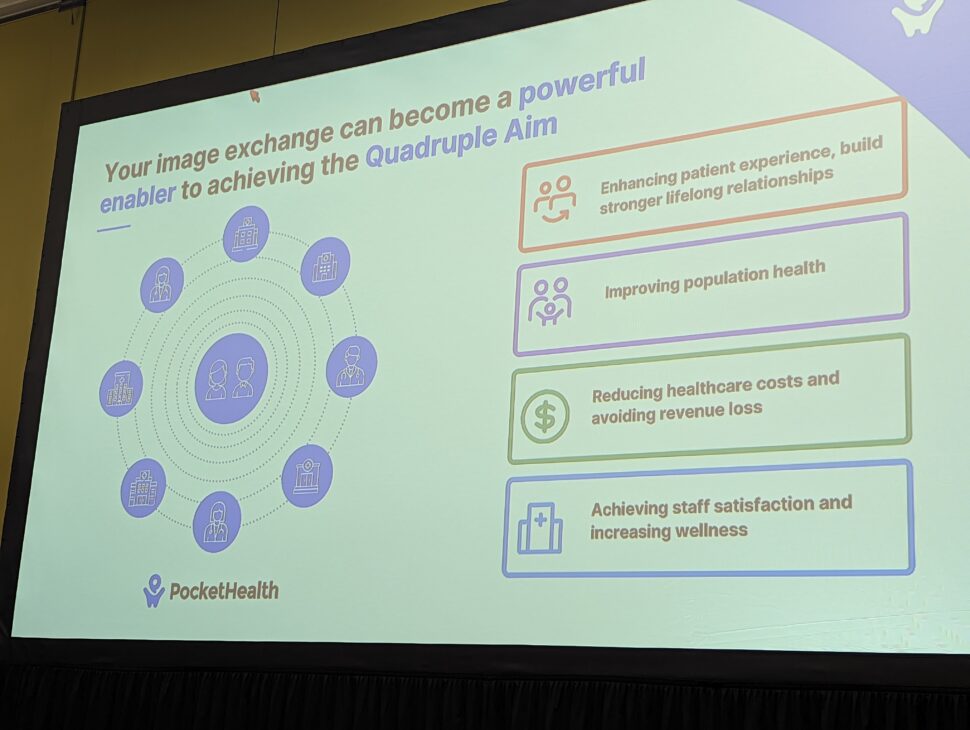A panel of radiology experts at RSNA23 put the spotlight on the important role radiology plays in achieving the quadruple aim. The panelists unanimously agreed that radiologists have a significant impact on a patient’s care journey and population health.
At the 2023 RSNA Conference in Chicago, PocketHealth hosted a lunch and learn event on Day 1. This special event featured a panel of radiology and data sharing experts:
- Rishi Nayyar – Co-Founder & CEO at PocketHealth (moderator)
- Aimee Langan – Director, Diagnostic Imaging and Laboratory Services at William Osler Health System
- Ajay Kohli, MD, MBA – Assistant Professor, Radiology and Orthopaedic Surgery at UT Southwestern Medical Center and Deputy Medical Informatics Officer at Parkland Hospital
- Frank Manole, DNP, MSN, MBA, FAANP – Chief Operating Officer at Raleigh Radiology
- Ram Chadalavada – Vice Chair of Radiology at University of Cincinnati
Radiology and the Quadruple Aim
To set the tone for the panel discussion, Nayyar opened the session by highlighting the tie between radiology and healthcare’s quadruple aim – enhancing patient experience, improving population health, reducing costs, and improving the work life of healthcare providers.
In particular Nayyar spoke about the role that image exchange can play:

Kohli added that when images are readily available when clinicians need them, they can quickly get to the heart of the medical issue of the patient in front of them. This is what both patients and clinicians ultimately want.
Access to Images Improves Population Health
Langan provided key insight into the impact that access to images can have on population health. She how at her facility, staff saw a noticeable uptick in patient engagement when patients had ready and easy access to their images and other medical data.
“It is, after all, THEIR DATA,” said Langan. “It is empowering when they gain access to it and it helps put them at the center of their own care.”
Technology Helps with Imaging Staff Shortages
A dose of reality was provided by Chadalavada who shared that since the COVID-19 pandemic, it has been difficult to keep imaging support staff.
“Many have moved onto other, more advanced roles, at the hospital or have left the industry altogether,” said Chadalavada. “It has been hard to backfill those roles. That’s where technology can help.”
Technology like what Pocket Health provides – streamlining the sharing of images with patients and fellow clinicians. Having this type of technology can help smaller teams do more.
Addressing Revenue Leakage
The best comment came from Manole when asked about the impact that radiology and image exchange can have on revenue: “They best way to address revenue leakage is not to have it.”
A study found that:
- 85% of patients preferred healthcare providers that provided online record access
- 85% felt that online access would increase their trust with that healthcare provider
- 91% believed it would increase their satisfaction with their care
“Patients don’t want to wait on hold,” said Manole. “They don’t want to go through a complex process to book an appointment. They don’t want to jump through your hoops to retrieve their data or images. People have choices new on where they go to get care. Keep things simple!”
Manole’s comments are inline with this study’s findings. Organizations need to do more than just offer online access, they need to make the entire process of online engagement more effortless and seamless. Doing this will not only attract new patients, but will retain existing ones as well.
Images Not Just Reports
At the end of the panel, a member of the audience asked a key question: Is access to reports enough or is access to images needed. Plus, does having the images lead to better care?
Langan responded by sharing her personal experience. Given her role, she is sometimes asked by friends and family to help navigate the healthcare system. By looking at their complete record, including images, Langan could arm her loved ones with information for their visit.
“I am able to be a better advocate for them or make them a better advocate,” Langan said.
Chadalavada answered from a macro perspective. He stated that the best care comes from a multidisciplinary approach…an approach that is only possible if every team member has access to the images and not just the reports. “Reports are good, but seeing the image is necessary for other members of the team to give their best input,” stated Chadalavada.
Other Notable Moments
There were two other notable moments from the panel discussion.
At the start of the panel, Nayyar pointed out how the patient voice was not always included in these types of discussions (I agree!). He then proceeded to play a recorded message from a patient who had found it very helpful to have ready access to their images via PocketHealth’s app.
That patient turned out to be Kristy Dickinson, who spoke at the recent Swaay.Health Toronto event. Unsolicited Kristy said: “I feel strongly that free-flowing imaging exchange is integral to improved care and patient experience – and I am a proud user of PocketHealth because they are the leaders in this space.”
The other notable moment came as a statement from Langan. In one of her responses she reminded the audience that some of the most difficult patient journeys begin with an image. Cancer screenings, CT scans, X-rays, etc. All of these are a prelude to a diagnosis that may be the hardest thing a person has ever had to face. To Langan this is an opportunity for healthcare organizations and in particular, the radiology department to demonstrate empathy.
Watch the panel discussion at https://www.pockethealth.com/2023/12/07/rethinking-image-exchange-industry-panel-at-rsna-2023/
Learn more about PocketHealth at https://www.pockethealth.com/
PocketHealth is a sponsor of Healthcare Scene.













